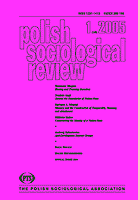Anti-Development Interest Groups (Preliminary Outline)
Anti-Development Interest Groups (Preliminary Outline)
Author(s): Andrzej ZybertowiczSubject(s): Social Sciences
Published by: Polskie Towarzystwo Socjologiczne
Keywords: "dirty social capital; interest group; common good; intelligence services
Summary/Abstract: In Poland there exists a phenomenon of a “diagnosiswithout consequences”—numerous structural deficiencies of the Polish state, although recognized as such for years, are not met by any consistent counteraction. To explain the phenomenon, this article introduces the concept of Anti-Development (parasite) Interest Groups (ADIGs). In contemporary Poland, the parasite, informal interest groups—probably present in any modern political system—are characterised by the following features: 1) they are embedded in the core zone of the state organism or have direct access to such zone; 2) they render the Polish state incapable of acting for the sake of common good; 3) they are aggregated (coordinated) in a way that enables them to function as a self-regulating system which actively penetrates the social environment and not only flexibly reacts to threats but also is able to neutralize some of them in advance; and 4) the most powerful ADIGs are bound together by resources andmethods inherited from the Communist intelligence services. The author subscribes to Zdzisław Krasnodębski’s thesis that “…two transformations occurred in Poland.Overt, which consisted in the transformation of the structures of the Communist state and economy into formal institutions of parliamentary democracy and market economy and another transformation—covert—which consisted in local modification and shaping (interpretation) of the new institutions and rules in order to make them serve the transformed Communist elites and co-opted segments of the elite originating from the former opposition.” This work reconstructs principles governing the behaviour of agents whose activities generate the “other” transformation.
Journal: Polish Sociological Review
- Issue Year: 149/2005
- Issue No: 1
- Page Range: 69-90
- Page Count: 21
- Language: English

